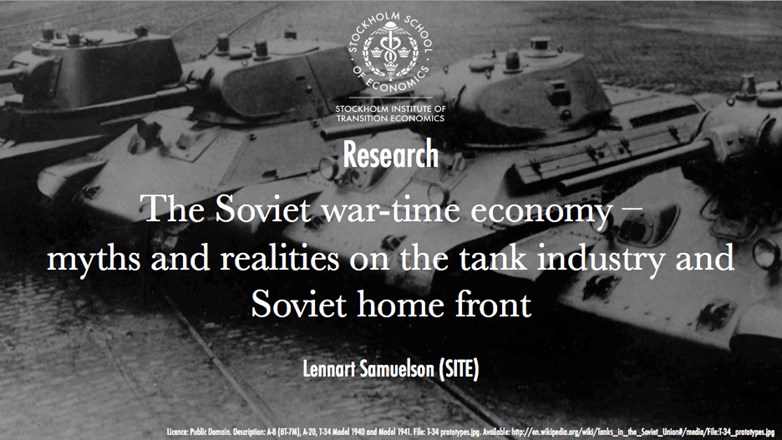Research of formerly secret archives sheds new light on the Soviet wartime economy
Professor’s work on Soviet Union, preserved in several books, covers daily life and strivings of the people in the Urals who transformed a slumbering provincial city to a central element in Russia’s defence industry (Tankograd: The Formation of a Soviet Company Town: Cheliabinsk, 1900s-1950s), Soviet industrial mobilization planning for the event of war (Soviet defence industry planning: Tukhachevskii and military-industrial mobilisation, 1926-1937) and Soviet military-economic planning (Plans For Stalin's War Machine: Tukhachevskii and Military-Economic Planning, 1925-1941). His leading books and pertinent articles are translated into Russian and are also widely used there as pioneering works on the links between the Red Army High Command, on the one hand, and the State planning organs, on the other hand. Lennart Samuelson has thus contributed to the renewal of historical research on the Soviet Union and in year 2000 he received the newly established Hugo Raab Prize from the Swedish National Defence College (Försvarshögskolan) for solid contributions to military-historical research, and, in 2007, the Tilas Prize for highly useful military-historical efforts. Last year, the Royal Swedish Academy of the Humanities (Vitterhetsakademin) awarded him with prestigious Rettig Prize for ‘his innovative and internationally recognized research on the history of the USSR and Russia, where he in an almost unique manner has delved into the Russian archival materials’.
Recently professor Samuelson gave an interview that was used for a new Russian documentary ”The Iron Flood” (Zheleznyi potok, an allusion to a famous novel from 1924 by Alexander Serafimovich) that describes the “war of the factories” in the Soviet Union and Nazi Germany, prior to and during the Second World War. The documentary is focused on the evolution of tanks technology in the USSR and Nazi Germany. It describes the extreme conditions under which the Soviet war-economic potential was re-created in the eastern regions after evacuation, during summer – autumn 1941, of some 1,500 factories from the Ukraine and western regions of European Russia. The Cheliabinsk Tractor Factory (ChTZ, started in 1933) was converted to a tank-producing unit in 1941-42 after the addition of workshops from factories in Leningrad, Charkov and other cities. During the interview professor Samuelson refers to his earlier work that reveals how unprepared Nazi Germany was with their military tank equipment facing Soviet tanks KV-1 and T34 in the battlefield. He also describes the benefits of simplicity in the design of Soviet military equipment that (a) allowed evacuating tank production facilities and engineers from the frontline of the war to more safe places in the Urals, (b) made possible mass production albeit scarce labour resources, and finally, (c) the possibility to repair damaged tanks at field workshops near the battle-scenes so that parts from two or more tanks could easily be used to set up a new one; this was in sharp contrast to the more ‘sophisticated’ technology used by Ferdinand Porsche’s designers for the famous German Panther and Tiger tanks. You can watch Russian documentary ”The Iron Flood” (in Russian) – sent on 5 May 2015 on Russian “TV Culture” here.
In addition to the interview on evolution of tanks industry in the USSR, professor Samuelson has written a FREE policy brief “New Light on the Eastern Front – Contributions from Russia to the 70th Anniversary of the Victory in Europe in World War Two”. This policy brief provides interesting insights of the post-Soviet research on the Second World War that is now presented in 12 imposing volumes, Velikaia Otechestvennaia Voina 1941 –1945 (Great Patriotic War 1941–45) written by specialists in military, political, international and economic history. Their style contrasts positively against Soviet works during the Cold War, and also against historical trends in recent years in the West, with an overt or covert anti-Russian undercurrent. Open archives, abolition of censorship, freedom of print as well as joint projects with Western scholars are the preconditions for progress in the historiography of Russia in the 20th century in general and of the Eastern Front during World War Two in particular.
Read more about the Nazi German-Soviet clash and new sources of information for historians in the policy brief “New Light on the Eastern Front – Contributions from Russia to the 70th Anniversary of the Victory in Europe in World War Two” here or read it on our SlideShare channel below.




